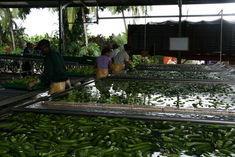
Despite the sheer breadth and scope of the supply chain, it must still feel bizarre for workers sweating in the heat of a Central American banana plantation that some trade negotiators in suits on a continent they may never visit are signing a piece of paper that could have a very real consequence on their wage.
While it is largely acknowledged that the EU’s ratification of the banana trade deal this month will take some time to have any real effect, concerns over the landmark document’s impact have been very much immediate.
US multinationals are likely to enjoy better access to the EU market, while ACP producers are likely to see their market share shrink and income decline.
The realistic short-term impact will most likely depend on where and how wisely the €200 million of aid from the EU to ACP producers is spent.
A recent study into the UK banana market’s structure by dedicated charity Banana Link revealed that 30,000 plantation and packhouse employees work for either seven large producers or 5,000 small farmers. Beyond them in the chain, five importers or ripeners control 90 per cent of the market with 10 retailers controlling the same percentage of consumer sales. The charity argues that this “boon or bottleneck” model puts strain on the supply chain and is top heavy. If and how the EU deal, or perhaps more pressingly, supermarket direct sourcing plans, will impact on this structure remains to be seen.
Canvassing opinions of suppliers in Berlin last week, fears over supermarkets’ direct sourcing plans in the banana category range from minor to despondent resignation.
One supply boss told FPJ that “so much cost has already been taken out of the supply chain that the only way the supermarkets can make any further savings is to compromise on quality”.
Another large-scale supplier said that eventually retailers “would make it work, because they always do” but stressed the added value suppliers provide was currently still “invaluable”.
He added: “I believe unfortunately that quality and shelf life will suffer. They do not have the necessary technical expertise that importers and exporters have in place at source. The logistical side of things may be more straightforward but it is the emphasis on cost over quality that is really concerning as poor quality will eventually drive consumers away from the category and decrease its value.”
There have been signs that supermarkets are stepping up their efforts with Morrisons said to be sourcing more product direct from Ecuador, Colombia and Costa Rica.
Supplies of bananas have been unusually disrupted in the last quarter with Latin America suffering a series of setbacks which saw a knock-on effect on price.
Hurricane Tomas devastated banana output in the Windward Islands when it hit central America in November, while some plantations in Costa Rica also suffered from the high winds.
An outbreak of sigatoka in the Dominican Republic before Christmas has hindered output, cutting volumes by around 40 per cent and fears that the number of smaller producers in that country will hold back exports remain very real. Floods in Colombia have affected supplies emanating from the South American source and experts believe it may be April before supplies are back on track.
In addition, the EU has asked shipping lines to pull out of shipping from the Ivory Coast, Cameroon and Ghana to temporarily stifle trade. Most of the shipping lines have pulled out at the request of the EU but CMA CGM and AEL are running services into Dover.
One source said forecasting has become a tough game. “It is hard to predict even six weeks ahead at the moment,” he said. “We had a very strong start to the year and extremely high prices for bananas in Europe, with prices reflected in the wholesale markets. We could well see a market that will come back into the balance with decent prices and good supply in the next six months. We are already seeing more fruit available and that is going to impact very quickly. It is more about longer term availability. I suspect there will not be too much oversupply this year but we will be fine as long as there are no severe hurricanes.”
Whichever way you look at it, from the deal signing or fruit harvesting end of the spectrum, there is still likely to be plenty of twists and turns to come in this most extraordinary of times.



